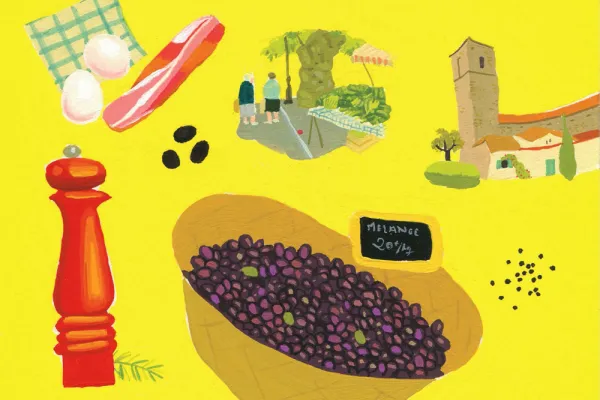A Destination to Desire
Alum News

Published December 9, 2016
In October 1970, on her popular television show The French Chef, Julia [McWilliams] Child [’34] was suddenly in color. She had a new, larger studio kitchen and dining room, and she was no longer confined to the studio space.
In 16 episodes of the 1970–71 season, she appeared in scenes shot in France in the previous months. For the first time she presented French food as prepared and sold by French hands.
She and her husband, Paul Child, had taken their typical summer vacation in Provence in 1970. But, in addition, they had gone around the region, as well as to other places in France, with members of the camera crew from WGBH, the Boston public television station from which the program originated. As usual, the Childs had prepared carefully in advance, determining “the sites to visit and the people to see.” The crew filmed Julia at outdoor food markets and small specialty food shops or inside taking lessons from professional cooks. She conversed with merchants and artisans, observed demonstrations of techniques, and made the viewer want to be there. A particular half-hour show might have one French segment or as many as four; some segments were as short as one minute, some were as long as 10.
By this time, Julia Child was already a celebrity, not merely a cookbook writer and a demonstrator of cooking techniques. In November 1966, she had appeared on the cover of Time magazine. In 1968, she had hosted a special program on the White House kitchen as it prepared a grand banquet. In the segments filmed in France in 1970, she was genial mistress of ceremonies to French fishwives, olive sellers, bakers and other artisans, engaging them in conversation in French and translating as needed for American viewers.
Provence appeared in all its glory. It was magnificently beautiful as the camera focused on the flower market in Grasse or panned over the landscape nearby to reveal the Childs’ second home in Plascassier. It was rough and real as the fishwives at the Old Port in Marseille shouted their wares and bantered with their customers. It was skilled and precise as a master artisan demonstrated the making of a magnificent paté en croute or as Simca Beck worked the dough in Julia’s Plascassier kitchen. It was mouthwatering as the maître d’hôtel of a restaurant in St. Paul-De-Vence roasted a huge leg of lamb hanging vertically in an outdoor oven and then carved it at Julia Child’s table in the shade.
In a vivid episode, Child explored the weekly market in Grasse on her way to a crèmerie, a shop selling dairy products, to buy crème fraîche, a product then rarely available in U.S. grocery stores. The camera shows her strolling around the outdoor market, admiring its abundant vegetables and buying flowers. She and viewers watch as the shopkeeper in the crèmerie pours out the thick crème fraîche into a cup—dramatically moving the ladle higher and higher—for Child to purchase and take away. In the studio, Child follows with instructions to the American home cook for making a simulation of crème fraîche in her kitchen, but, of course, it isn’t the same. One wants to be by her side in Grasse, buying and then tasting the real thing.
As the camera shifts to the Plascassier landscape, the viewer pines to be there. Child invites this. Her usually high-pitched voice softens to caress the word “Provence.” As a man and a woman pick roses nearby, Child intones, “And the air is mostly lovely-smelling country. You smell the olive blossoms and the linden trees and the wild herbs. … And just look at all those flowers.” When the camera shows the exterior of the Marseille fish market and then moves inside, she says that she wants you to “see it and hear it.” As the outdoor market at Grasse comes into view, she states enthusiastically, “I’d love you to see this market.” These sun-filled views must have been all the more appealing to her North American audience when shown in the depth of the harsh winter of 1971. And always, there was Julia Child herself, her welcoming presence guiding throughout—commenting, translating and praising with her indomitable enthusiasm. In the era when she emerged as an icon of Americans’ new delight in food, she offered on the small screen enticing demonstrations of one of the prime pleasures of staying awhile in Provence. Julia Child might not have known it, but she was an early actor in the drama of the selling of Provence to Americans as a destination to desire.
This story appears in the Winter 2016-17 issue of the Smith Alumnae Quarterly.
Learn More
Provence of the Imagination
What she overlooked on a youthful trip to France leads Helen Horowitz to consider how one hilly region has come to be adored by travelers and food lovers the world over.
Cooking in Julia’s Kitchen
Julia Child’s beloved Provençal cottage—now owned by another Smithie—sets the scene for a magical week of cooking, friendship and hero worship.
Reprinted with permission from A Taste for Provence by Helen Lefkowitz Horowitz, published by the University of Chicago Press. © 2016 by The University of Chicago. All rights reserved. Illustration by Juliette Borda